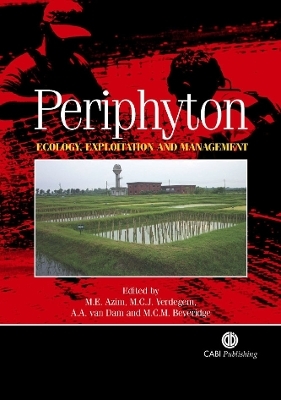
Periphyton
CABI Publishing (Verlag)
978-0-85199-096-5 (ISBN)
The first comprehensive monograph on periphyton, this book contains contributions by scientists from around the globe. Multi-disciplinary in nature, it covers both basic and applied aspects of periphyton, and is applicable worldwide in natural, extensive and intensive managed systems. Periphyton, as described in this book, refers to the entire complex of attached aquatic biota on submerged substrates, including associated non-attached organisms and detritus. Thus the periphyton community comprises bacteria, fungi, protozoa, algae, zooplankton and other invertebrates. Periphyton is important for various reasons: as a major contributor to carbon fixation and nutrient cycling in aquatic ecosystems; as an important source of food in aquatic systems; as an indicator of environmental change. It can also be managed to improve water quality in lakes and reservoirs; it can greatly increase aquaculture production; it can be used in waste water treatment. The book provides an international review of periphyton ecology, exploitation and management. The ecology part focuses on periphyton structure and function in natural systems. The exploitation part covers its nutritive qualities and utilization by organisms, particularly in aquaculture. The final part considers the use of periphyton for increasing aquatic production and its effects on water quality and animal health in culture systems. This book will help scientists and entrepreneurs further understand the ecology and production of aquatic systems and venture into new and promising areas.
1: Periphyton and Aquatic Production: An Introduction, M E Azim, SaitamaUniversity, Japan, M C M Beveridge, A A van Dam, The Netherlandsand M C J Verdegem, 2: Periphyton Structure, Diversity and Colonization, M E Azim and T Asaeda,Saitama University, Japan 3: Periphyton Dynamics and Influencing Factors, J E Vermaat, VrijeUniversiteit Amsterdam, The Netherlands 4: Periphyton in the Aquatic Ecosystem and Food Webs, R G Wetzel,University of North Carolina, USA 4: Periphyton in Freshwater Lakes and Wetlands, L G Goldsborough,University of Manitoba, Canada, R L McDougal, Ducks Unlimited Canada,Canada and A K North, Red River Basin Commission, CanadaEXPLOITATION 5: Utilization of Periphyton for Fish Production in Ponds: a Systems EcologyPerspective, A A van Dam and M C J Verdegem 6: Adaptations to Feeding in Herbivorous Fish (Cyprinidae and Cichlidae),F A Sibbing, Wageningen University, The Netherlands and F Witte, LeidenUniversity, The Netherlands 7: Traditional Brush Park Fisheries in Natural Waters, R L Welcomme,Imperial College of Science, Technology and Engineering, London, UK 8: Periphyton (Biofilms) as Biological Indicators in Managed AquaticEcosystems, S Sabater, University of Girona, Spain and W Admiraal,University of Amsterdam, The NetherlandsMANAGEMENT 9: Effect of Periphyton on Water Quality, A Milstein, Agriculture ResearchOrganization (ARO), Israel 10: Similarities between Microbial and Periphytic Biofilms in AquacultureSystems, M C J Verdegem, E H Eding, V Sereti, R N Munubi, R A Santacruz-Reyes, Wageningen University, The Netherlands, and A A van Dam 11: Periphyton-based Pond Polyculture, M E Azim and M A Wahab, BangladeshAgricultural University, Bangladesh 12: Research on Periphyton-based Aquaculture in India, P Keshavanath andB Gangadhar, University of Agricultural Sciences, Bangalore, India 13: Periphyton-based Cage Aquaculture, S M H Huchette, University of Melbourne, Australia and M C M Beveridge 14: Utility of Added Substrates in Shrimp Culture, J H Tidwell,Kentucky State University, USA and D Bratvold, University of Georgia, USA 15: Importance of Periphyton in Abalone Culture, T Kawamura,University of Tokyo, Japan, R D Roberts, Cawthron Institute,New Zealand and H Takami, Tohoku National Fisheries Research Institute,Japan 14: Periphyton-based Aquaculture in Asia: Livelihoods and Sustainability,S W Bunting, M Karim, University of Stirling, Scotland, UK andM A Wahab 15: Periphyton Ecology, Exploitation and Management: Knowledge Gapsand Directions for Future Research, M C J Verdegem, A A van Dam,M E Azim and M C M Beveridge"
| Erscheint lt. Verlag | 18.11.2005 |
|---|---|
| Verlagsort | Wallingford |
| Sprache | englisch |
| Maße | 172 x 244 mm |
| Themenwelt | Naturwissenschaften ► Biologie ► Limnologie / Meeresbiologie |
| Naturwissenschaften ► Biologie ► Mikrobiologie / Immunologie | |
| Naturwissenschaften ► Biologie ► Ökologie / Naturschutz | |
| Weitere Fachgebiete ► Land- / Forstwirtschaft / Fischerei | |
| ISBN-10 | 0-85199-096-7 / 0851990967 |
| ISBN-13 | 978-0-85199-096-5 / 9780851990965 |
| Zustand | Neuware |
| Haben Sie eine Frage zum Produkt? |
aus dem Bereich


